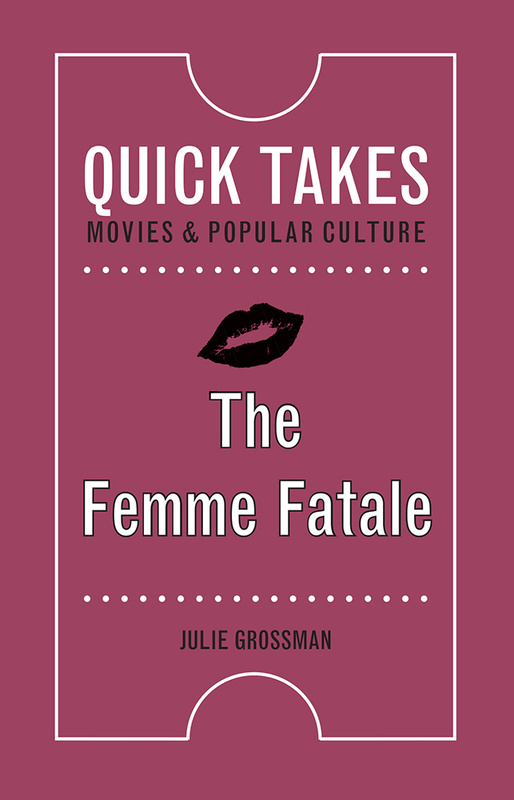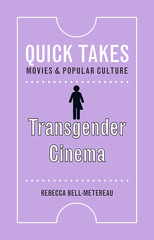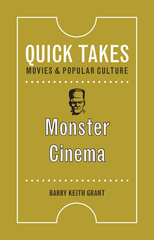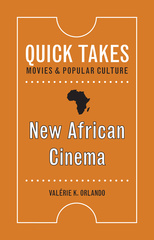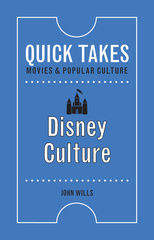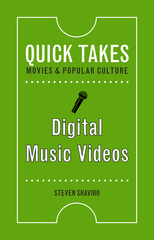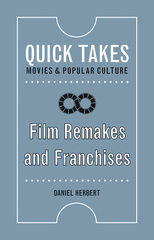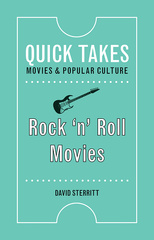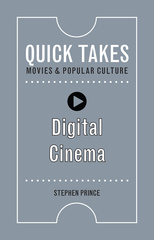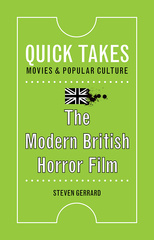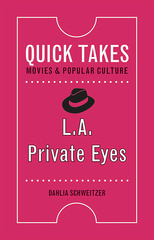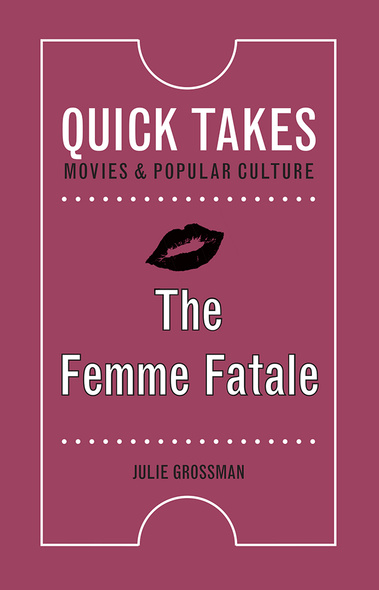
174 pages, 4 1/2 x 7
Paperback
Release Date:18 Sep 2020
ISBN:9780813598246
Hardcover
Release Date:18 Sep 2020
ISBN:9780813598253
The Femme Fatale
Rutgers University Press
Ostensibly the villain, but also a model of female power, poise, and intelligence, the femme fatale embodies Hollywood’s contradictory attitudes toward ambitious women. But how has the figure of the femme fatale evolved over time, and to what extent have these changes reflected shifting cultural attitudes toward female independence and sexuality?
This book offers readers a concise look at over a century of femmes fatales on both the silver screen and the TV screen. Starting with ethnically exoticized silent film vamps like Theda Bara and Pola Negri, it examines classic film noir femmes fatales like Barbara Stanwyck in Double Indemnity, as well as postmodern revisions of the archetype in films like Basic Instinct and Memento. Finally, it explores how contemporary film and television creators like Fleabag and Killing Eve’s Phoebe Waller-Bridge have appropriated the femme fatale in sympathetic and surprising ways.
Analyzing not only the films themselves, but also studio press kits and reviews, The Femme Fatale considers how discourses about the pleasures and dangers of female performance are projected onto the figure of the femme fatale. Ultimately, it is a celebration of how “bad girl” roles have provided some of Hollywood’s most talented actresses opportunities to fully express their on-screen charisma.
This book offers readers a concise look at over a century of femmes fatales on both the silver screen and the TV screen. Starting with ethnically exoticized silent film vamps like Theda Bara and Pola Negri, it examines classic film noir femmes fatales like Barbara Stanwyck in Double Indemnity, as well as postmodern revisions of the archetype in films like Basic Instinct and Memento. Finally, it explores how contemporary film and television creators like Fleabag and Killing Eve’s Phoebe Waller-Bridge have appropriated the femme fatale in sympathetic and surprising ways.
Analyzing not only the films themselves, but also studio press kits and reviews, The Femme Fatale considers how discourses about the pleasures and dangers of female performance are projected onto the figure of the femme fatale. Ultimately, it is a celebration of how “bad girl” roles have provided some of Hollywood’s most talented actresses opportunities to fully express their on-screen charisma.
A fascinating exploration of Hollywood’s most notorious female that goes beyond film noir. With a focus on the performance of gender as subversive and empowered, Grossman illuminates over a century of femme fatales from silent cinema’s 'Vamp' Theda Bara to television’s Killing Eve.
In this lively and engaging book, Julie Grossman elegantly traces the long tradition of the femme fatale figure in film, television and popular culture. She deftly analyses a diverse range of characters, from Theda Bara’s vamp in early Hollywood, the hard-boiled dames of classic Film Noir, to the complex and vibrant Villanelle in contemporary television’s Killing Eve. Grossman persuasively illustrates the centrality of role performance to these femme fatale figures, and establishes performance as a key mode by which they resist inequalities in social structures. This book provides both a history of how women have been represented, and a compelling case for the relevance of the femme fatale to contemporary debates on gender politics.'
JULIE GROSSMAN is a professor of English and communication and film studies at Le Moyne College in Syracuse, New York. Her books about film, television, literature, and gender include Ida Lupino, Director: Her Art and Resilience in Times of Transition (with Therese Grisham), Rethinking the Femme Fatale in Film Noir: Ready for Her Close-Up, Adaptation and ElasTEXTity: Literature, Film, and Their Hideous Progeny, and Twin Peaks (with Will Scheibel).
Introduction
Intelligent, witty, able to role-play and perform, deceptive, enraged, frustrated, mercenary, seductive, overtly sexual, fearless and tough as nails, physically self-confident with a striking appearance: these are the qualities we associate with the femme fatale. The figure is commonly understood as a beautiful woman who seduces a male protagonist into criminality and a web of deceit, causing his demise and, when film industry production codes required, her own death too. The femme fatale has always been perceived as a staple of classic film noir (generally thought to date from The Maltese Falcon [1941] to Touch of Evil [1958], the dangerous dame seen as a counterpart to the slick and cynical male detective.
As many are aware, classic film noir refers to the series of brooding post-WWII films characterized by low-key lighting, an emphasis on urban anonymity and alienation, the seductions of criminality, and cool-cat highly metaphorical language drawn in part from the hardboiled fiction of James Cain, Raymond Chandler, Dashiell Hammett, and Ernest Hemingway. Hemingway penned a quintessentially dark exchange in his short story “The Killers”: “’What’s the idea?,’ Nick asked. ‘There isn’t any idea,’” returns one of the hired killers. This kind of playful nothingness becomes endemic in film noir, which sleekly adapts a literary vernacular and melds it to compelling character patterns. In Out of the Past (1947), Jeff Bailey [Robert Mitchum] tells a cabbie, “I think I'm in a frame...I don't know. All I can see is the frame”; in The Sweet Smell of Success (1957), J.J. Hunsecker (Burt Lancaster) says to Sidney Falco (Tony Curtis), “you’re dead, son. Get yourself buried.” While the focus in film noir has habitually been on the beleaguered tough guy, for whom the irony in such language becomes a defense against the fear of living meaninglessly, women in noir share this world-weariness, despite viewers’ and critics’ conventional focus on the hardboiled male and the women’s part in adding to the troubles of men. Indeed, a close look at film noir’s ingrained character patterns reveals the classic femme fatale brandishing many of the qualities we associate with the male noir protagonist. In The Big Heat, Debby Marsh (Gloria Grahame) comments as she enters Detective Dave Bannion’s (Glenn Ford) barren hotel room, “I like it. Early nothing.” Debby’s line alludes to the visible boundaries of nothingness, and that angst-ridden insight, while traditionally associated with men in noir, is crucially important for understanding noir’s modern women as they strive to find meaning outside of oppressive social roles.
The hardboiled women in noir show their rage or malaise differently from how postwar fraught masculinity is expressed, where tough leading men are more able to sublimate their unease and disappointments into a workable cynicism and an appealing “cool” demeanor that complements their masculine competence. For women, displaying such cynicism breaks the conventional gender mold, threatening the cultural idolatry of mothers and virgins. Johnny Clay (Sterling Hayden) tells Sherry (Marie Windsor) in The Killing (1956), "You like money. You’ve got a great big dollar sign there where most women have a heart." Bad boys have always been more easily adapted into accepted social types; bad girls, however, are demonized and often punished for their resistance to social norms.
One of the main ways that film noir’s classic femme fatale has rebelled against social conventions and pushed against boundaries is by roleplaying. There is, I will suggest throughout this volume, an abiding relevance in the practice and notions of performance embedded in the idea of the classic femme fatale, not only because cinema’s fatal women are so often portrayed by strikingly charismatic actors but also because the theme of performance captures the double-bind active and rebellious or transgressive female characters find themselves in: they perform roles sometimes to escape objectification or the rigid or socially sanctioned positions that oppress them, but then when they assume or “perform” unconventional or unprescribed roles, their ambition to find fulfillment outside of convention constitutes them as “bad actors,” as deceptive, inauthentic, or “spider women.”
Putting on “a show,” performing femininity while charting the damage done to women because of predatory men and institutional biases is trademark femme fatale. A serious rejoinder to institutional sexism, the most compelling femmes fatales show two paths taken by women as a result of their privation and sense of loss, violation, or unfulfillment: desperate grabs for power or happiness, or a mocking vengeance against those who have contributed to their desolation. Both avenues usually involve criminality. This book attends to the stories of femmes fatales, delineating their words and behavior as insurgencies against conventional gender categories that are insidious. The figures addressed in this book are dangerous women whose sly rebellions against the status quo offer images and portraits of strong defiant women.
Viewer obsessions with the femme fatale replicate the noir men’s fascination with and dread of the powerful woman. Indeed, female badness is ripe for exploitation as a theme with a ready audience. We find over the centuries a deeply rooted cultural habit of glomming onto the titillating icon of the bad woman, the Eve or Lilith figure that threatens patriarchy and individual men whose loss of control can then be blamed on the woman: as Rita Hayworth sings in Gilda (1946), first rebelliously, then plaintively, “Put the Blame on Mame.” With its sex and glitter, the icon can blind us from evaluating nuanced representation that is crucially inflected with vibrant female performance. For example, none of Lauren Bacall’s roles in classic film noir included a “badness” associated with the idea of the deadly female. When Bacall first exploded onto the Hollywood scene in 1944, the Motion Picture Daily Review captured this powerful and misleading dynamic by associating Bacall’s seductiveness with villainy: “Her deportment has a decided “come-hither” look and her brand of acting is purring and tintillating [sic] in the slow-cooking manner: She is the bad girl . . . ” (Kann, To Have and Have Not). A pickpocket in To Have and Have Not (1944), Marie Browning (Bacall) lives on the edge to survive, but the focus here on the threat she poses is part and parcel of the cultural dynamics that determine and continually reinscribe the role of the femme fatale. Further, there is a moment in To Have and Have Not when Bogart comments on Marie’s manipulation, “You’re good. You’re awful good,” a judgment that speaks to the woman’s powers of artifice. This is a theme that will recur in this study: female characters branded as femmes fatales perform roles in order to survive, to seduce, or to manipulate others in order to get what they want, yet any “pretense” to better their position is received as immoral and invites male scorn. Female dissimulation means that Marie is a “good” performer, but that makes her untrustworthy. Because Marie’s role as femme fatale is subordinate in her noir films to Bacall’s partnership with Bogart, her characters are rewarded with romance and happy endings. But the exchange about how awfully “good” she is exposes an ideology of mistrusting women that sends a message that women are bad even when they are “good,” and this is because they are not in these cases “good” as a gendered ideal—angel in the house, domestic savior--but good at something, such as performance or work in general. It is then when they are often perceived as threatening. Marie’s sarcastic comment to Steve later in this conversation is thus fitting: “Who was the girl . . . . the one who left you with such a high opinion of women?” Marie’s exchange with Steve offers a kinder version of Devlin’s (Cary Grant) disdain for Alicia’s (Ingrid Bergman) performance as Alex Sebastian’s (Claude Rains) wife in Notorious (1946)—“Dry your eyes, baby; it’s out of character”--or Jeff Markam’s cynical repetition to Kathie Moffatt that she is “good” in Out of the Past: “Oh, you’re good, Kathie.” Kathie is murderous, like Brigid O’Shaughnessy in The Maltese Falcon, but these two female characters become the benchmark for other women in noir, particularly in the way they perform and dissemble. In The Maltese Falcon, Spade also says “You’re good” to Brigid, followed by “It’s chiefly your eyes … and that throb you get in your voice.” Brigid responds, “it’s my own fault if you can’t believe me now,” and Spade confirms that it is female performance that is most threatening: “Now you are dangerous.” Men within these films and often the viewers cathecting on the role of the femme fatale are especially alert to female dissimulation, when there are important distinctions to be drawn among these many energetic modern women whose motives vary.
In classic film noir, the destruction of the male protagonist and the fatal woman constitute a critique of the American Dream—its failed promise of success and happiness seen through the perspective of marginalized figures. By virtue of their gender, women were always already such outsiders, an insight feminist readings of film noir introduced beginning with the publication of E. Ann Kaplan’s edited collection Women in Film Noir in 1978 (reprinted with additional essays in 1998). Amidst second-wave feminisms, and, interestingly, on the eve of the 1980s rebirth of the fatal woman in neo-noir, this landmark volume analyzed the so-called bad women in classic film noir as a symbolic expression of shifting power roles and a destabilized family in 1940s America. The essays in the collection, such as Janey Place’s “Women in Film Noir,” opened up space for reading noir women in more positive terms, rather than simply as misogynist projections of male desire. The volume not only illuminated film noir’s relevance to feminist discourse and theory, demonstrated in Christine Gledhill’s book-end essays, but also found in psychoanalytic feminist theory a particularly resonant means of exploring different forms of agency, scopic regimes, and representation in film noir. Pam Cook’s and Claire Johnston’s essays, for example, paved the way for subsequent feminist psychoanalytic work on film noir, such as Mary Ann Doane’s Femmes Fatales: Feminism, Film Theory, Psychoanalysis (1991), which saw in the femme fatale’s masking and unknowability a powerful expression of male fears about female power, and also Joan Copjec’s collection Shades of Noir (1993). Shifting critical attention from men’s to women’s stories, Elizabeth Cowie argued in this volume against a traditional reading of film noir’s “mean streets” as a male “sphere,” refocusing feminist film criticism on noir “women[’s] roles which are active, adventurous and driven by sexual desire” (135). A later essay by Elisabeth Bronfen, published in New Literary History in 2004, lent the classic femme fatale a tragic dimension, Bronfen boldly taking as her example Phyllis Dietrichson of Double Indemnity, considered by many to be the opaque femme fatale par excellence. My own volume Rethinking the Femme Fatale in Film Noir: Ready for Her Close-Up (2009) argued that film noir’s femme fatale is a phantom, that when viewers examine closely many film noirs, they find so-called femmes fatales to be three-dimensional women who have their own stories to tell: difficult backgrounds and feelings of privation based on class and gender and the vitality to push against the limits of their experience in clever ways; their criminality is often a means of rejecting or rebelling against the constricting roles ascribed to or projected onto them. In their respective monographs, Helen Hanson and Philippa Gates “detected” and pursued the centrality of the female investigative role in film noir, Gates further averring in 2014 that the “female detective brings with her an idealism” that questions the centrality of cynicism in film noir (“Independence Unpunished” 33). And Hanson and Catherine O’Rawe’s 2010 collection The Femme Fatale: Images, Histories, Contexts explored the global, trans-historical, and feminist contexts that perennially shift the meaning of the femme fatale. As against this rich mining of the women’s stories in noir, the excessive portrayal of the pathological fatal woman in neo-noir seems in many ways to flatten the critical terrain, as I discuss in Part 2. At the same time, contemporary femmes fatales since the 1980s reinforce the continuing appeal of representations of bad women. As censorship has ceased to provide “cover” for depictions of women intended to be relentlessly bad, female villains compel viewers to confront many assumptions about gender that remain in force despite important shifts in power since the nineteenth century and film noir’s renaissance in the 1940s and 50s. Representations of bad women must be evaluated in terms of context, and while some of these figures may be simply sensationalist, others provoke consideration of traumatizing institutional and psycho-social biases.
The year 1895 inaugurated both the use of the phrase “femme fatale” in English (by George Bernard Shaw) and the birth of the cinema. Like the photographic and filmic image, the icon of the femme fatale marks an illusion but also documents a reality; it is there and not there. For this reason, insofar as critics and scholars locate the femme fatale within cinema, it is possible to find traces of her long before the innovation of film, not only in the figures of Eve, Lilith, and Keats’s “La Belle Dame Sans Merci,” but also in contemporary performance spaces and media as well, as the latter part of this book demonstrates. The femme fatale prods discussion and conversation about social roles and power dynamics that remain—pre- and post- #MeToo—important contexts informing depictions of “bad” women. This is not to say that all appearances of “bad” women throughout the history of media are critique-oriented, only to suggest that there are often counter-currents in these representations; sexism may sometimes be bound up in the operations of the femme fatale while this figure also manages to deconstruct patriarchy. This is why careful readings of this figure are so crucial.
At the end of a BBC radio program on film noir’s femme fatale in 2018, narrator Kathleen Turner (who played Matty Walker in Body Heat [1981]), shares her insight that when women are fully on an equal footing with men in society, there will no longer be a need for the femme fatale (Farran). Until then, Turner suggests, her presence and her potential are subversive. As attractive as this reading might be, the construction of the fatal woman as a necessary evil in a fallen world belies the pleasures the femme fatale affords and the creative forms of self-expression she pursues. Phoebe Waller-Bridge, author of the hit television shows Fleabag (2016-19) and Killing Eve (2018-), hosted Saturday Night Live(1975-) on October 5,t, 2019. In her opening monologue, she mused about continuities between herself and the character she plays, Fleabag, who is “sexually depraved, foul-mouthed, dangerous.” The obvious pleasure Waller-Bridge takes in owning this persona speaks to the feminist defiance often emerging from the figure of the femme fatale.
The femme fatale is an ongoing pattern and creative tool of gender critique and redefinition. As central a feature of classic noir and neo-noir as fatal women have been, this figure has also exceeded the genre or series as a cultural icon and popular representation. The femme fatale recurs throughout culture as a provocative figure of disruption, a means of questioning gender norms and cultural hierarchies. This short book describes the femme fatale’s enchanting machinations from the exploits of the silent-movie vamp to the striking words, actions, and demeanors of contemporary film and television’s fatal women. On the one hand, I take a long view of the femme fatale from her figuration in early film all the way to contemporary versions of the archetype, some of which are created by women for television, by creative artists such as Waller-Bridge, Mary Harron, Sarah Polley, and Margaret Atwood. On the other hand, in some sense, chronologies of the femme fatale across media won’t account for the importance of this figure’s iconicity. The femme fatale is a persistent feature of the American landscape, like the recurrent idea of the wild west, that goes beyond the boundaries of a chronological history by serving as a benchmark for attitudes toward women and social roles.
The legacy of the femme fatale strongly marks contemporary television and satire. Game of Thrones (2011-2019) challenges viewers with Cersei Lannister’s (Lena Headey) unrelenting cruelty. But Cersei’s nearly nihilist insistence on protecting her rule and her children is continually tied to her awareness of the culture’s contempt for women and disregard for their lives and desires. Thus we recognize the importance of the figure of the femme fatale, the fatal woman, in helping us to see the constraints placed on women and their insistence on breaking the chains of their confinement.
Saturday Night Live has repeatedly shown creative women using humor to ridicule sexist norms and blast the exploitation of women. In “Welcome to Hell,” a December, 2017 Saturday Night Live music-video skit, Aidy Bryant, Kate MacKinnon, Leslie Jones, Cecily Strong, Melissa Villaseñor, and guest Saoirse Ronan dress in pastels, long hair and head-bands, go-go boots, and mini skirts, licking candy canes and singing about a history of sexual harassment. Attired in sexy outfits and surrounded by pink lollipops, rainbows, zebras, stars, ice-cream cones, and balloons, the women coo seductively in valley-girl accents, “All these big cool powerful guys are turning out to be – what’s the word – habitual predators? Cat’s out of the bag, women get harassed all the time … and it’s like, dang, is this the world now? Here’s a little secret that every girl knows. (Shhhh.) This been the damned world.” Then, the sung refrain follows: “It’s freaky, it’s narsty, it’s fun under the dust bag. But this is our hometown. We’ll show you around. Welcome to Hell. Now we’re all in here.” In other words, “me too.” The skit underscores how miserable it is to live in a patriarchal society, where normal experience is hell. But the #MeToo movement has brought the femme fatale out of “the dark” and transformed the irony we associate with the smart-talking “dame” into conscious satire.
Contemporary female comedians have appropriated the figure of the aggressive female upstart; consider Mrs. Maisel’s raunchy standup comedy, or the title of Samantha Bee’s comedy-news show, “Full Frontal,” which casts Bee at the helm turning the gender tables as broadcaster of “the naked truth.” Bee’s remorselessness--from making the case on her television show in the fall of 2016 that Donald Trump can’t read, to vulgar yet thrilling name-calling--shows us how important humor is to the workings of the femme fatale, where we laugh at the incongruities she brings to light. The femme fatale isn’t an object or merely a projection but a pattern of representation that can reveal or expose the absurdities of gender exploitation and the traumas associated with gender bias.
Comedians such as Samantha Bee are to some extent emulating the tough-talking noir dame who resists, critiques, or lambastes the status quo. Contesting the power of smug men, Bee’s parodies could be likened to Lily Stevens’s (Ida Lupino) celebrated moment in Road House (1948), where Lily slaps the face of the presumptuous and controlling Pete Morgan (Cornell Wilde), saying dismissively, “Silly boy.” In Pitfall (1948), Mona Stevens (Lizabeth Scott) tells John Forbes (Dick Powell) that he’s “a little man with a briefcase.” As played by dynamic and charismatic performers such as Lupino and Scott, whose embodiment of the femme fatale emphasizes her agency and intelligence, the fatal woman calls out the arrogance of men; she is a foil to the hardboiled male protagonist and subverts the power of those around her and the social systems that preserve gender inequality.
The femme fatale critiques social structures and resets power relations. In that spirit, she is a critical force to be reckoned with, meriting an expansion of our interrogation beyond film noir, neo-noir, and even film texts. This is why Part 3 looks at Alexander Payne’s millennial satire Election (1999) and examples of golden-age network and “quality” television shows (Twin Peaks 1990-91; 2017), as well a contemporary British series (Killing Eve) and a mini-series adaptation of an historical novel (Alias Grace [2017]) on a streaming service. These texts provide opportunities to explore gendered power relations and cultural assumptions undergirding the femme fatale that reflect and may sometimes also provoke cultural anxieties. My methodology in this volume includes close reading of film and television texts and intertexts, paying particular attention to the magnetic performances by women such as Theda Bara and Barbara Stanwyck, or Reese Witherspoon and Jodie Comer and focusing on the moments of expressivity that help us to discern the resistance and power of the femme fatale, even as we observe her often complex and fraught subjectivity, or her militant opacity. I also bring in contextual material—reviews and studio press books, for example--that helps us to see how images of the fatal woman have been promoted by Hollywood and society at large. No doubt readers will miss seeing detailed consideration of their own favorite films and characters, and although the briefness of this study precludes discussing many major and classic noir movies, I try at least to refer to a lot of them and discuss texts and figures less extensively covered elsewhere and films I didn’t address at length in my earlier book on the femme fatale.
Sustained and repeated analysis of representations of “bad women” in popular and mainstream culture counteracts the cliché (often repeated in internet rankings of the “hottest” femmes fatales) that these female characters are simply seductive and malevolent. The case studies that follow are designed to show off the femme fatale’s style and language and to suggest not only the apparitional qualities of the haunting (and haunted) fatal woman but also her power to illuminate important and pervasive social-psychological dynamics in the way gender operates in our lives and the texts we are drawn to.
Intelligent, witty, able to role-play and perform, deceptive, enraged, frustrated, mercenary, seductive, overtly sexual, fearless and tough as nails, physically self-confident with a striking appearance: these are the qualities we associate with the femme fatale. The figure is commonly understood as a beautiful woman who seduces a male protagonist into criminality and a web of deceit, causing his demise and, when film industry production codes required, her own death too. The femme fatale has always been perceived as a staple of classic film noir (generally thought to date from The Maltese Falcon [1941] to Touch of Evil [1958], the dangerous dame seen as a counterpart to the slick and cynical male detective.
As many are aware, classic film noir refers to the series of brooding post-WWII films characterized by low-key lighting, an emphasis on urban anonymity and alienation, the seductions of criminality, and cool-cat highly metaphorical language drawn in part from the hardboiled fiction of James Cain, Raymond Chandler, Dashiell Hammett, and Ernest Hemingway. Hemingway penned a quintessentially dark exchange in his short story “The Killers”: “’What’s the idea?,’ Nick asked. ‘There isn’t any idea,’” returns one of the hired killers. This kind of playful nothingness becomes endemic in film noir, which sleekly adapts a literary vernacular and melds it to compelling character patterns. In Out of the Past (1947), Jeff Bailey [Robert Mitchum] tells a cabbie, “I think I'm in a frame...I don't know. All I can see is the frame”; in The Sweet Smell of Success (1957), J.J. Hunsecker (Burt Lancaster) says to Sidney Falco (Tony Curtis), “you’re dead, son. Get yourself buried.” While the focus in film noir has habitually been on the beleaguered tough guy, for whom the irony in such language becomes a defense against the fear of living meaninglessly, women in noir share this world-weariness, despite viewers’ and critics’ conventional focus on the hardboiled male and the women’s part in adding to the troubles of men. Indeed, a close look at film noir’s ingrained character patterns reveals the classic femme fatale brandishing many of the qualities we associate with the male noir protagonist. In The Big Heat, Debby Marsh (Gloria Grahame) comments as she enters Detective Dave Bannion’s (Glenn Ford) barren hotel room, “I like it. Early nothing.” Debby’s line alludes to the visible boundaries of nothingness, and that angst-ridden insight, while traditionally associated with men in noir, is crucially important for understanding noir’s modern women as they strive to find meaning outside of oppressive social roles.
The hardboiled women in noir show their rage or malaise differently from how postwar fraught masculinity is expressed, where tough leading men are more able to sublimate their unease and disappointments into a workable cynicism and an appealing “cool” demeanor that complements their masculine competence. For women, displaying such cynicism breaks the conventional gender mold, threatening the cultural idolatry of mothers and virgins. Johnny Clay (Sterling Hayden) tells Sherry (Marie Windsor) in The Killing (1956), "You like money. You’ve got a great big dollar sign there where most women have a heart." Bad boys have always been more easily adapted into accepted social types; bad girls, however, are demonized and often punished for their resistance to social norms.
One of the main ways that film noir’s classic femme fatale has rebelled against social conventions and pushed against boundaries is by roleplaying. There is, I will suggest throughout this volume, an abiding relevance in the practice and notions of performance embedded in the idea of the classic femme fatale, not only because cinema’s fatal women are so often portrayed by strikingly charismatic actors but also because the theme of performance captures the double-bind active and rebellious or transgressive female characters find themselves in: they perform roles sometimes to escape objectification or the rigid or socially sanctioned positions that oppress them, but then when they assume or “perform” unconventional or unprescribed roles, their ambition to find fulfillment outside of convention constitutes them as “bad actors,” as deceptive, inauthentic, or “spider women.”
Putting on “a show,” performing femininity while charting the damage done to women because of predatory men and institutional biases is trademark femme fatale. A serious rejoinder to institutional sexism, the most compelling femmes fatales show two paths taken by women as a result of their privation and sense of loss, violation, or unfulfillment: desperate grabs for power or happiness, or a mocking vengeance against those who have contributed to their desolation. Both avenues usually involve criminality. This book attends to the stories of femmes fatales, delineating their words and behavior as insurgencies against conventional gender categories that are insidious. The figures addressed in this book are dangerous women whose sly rebellions against the status quo offer images and portraits of strong defiant women.
Viewer obsessions with the femme fatale replicate the noir men’s fascination with and dread of the powerful woman. Indeed, female badness is ripe for exploitation as a theme with a ready audience. We find over the centuries a deeply rooted cultural habit of glomming onto the titillating icon of the bad woman, the Eve or Lilith figure that threatens patriarchy and individual men whose loss of control can then be blamed on the woman: as Rita Hayworth sings in Gilda (1946), first rebelliously, then plaintively, “Put the Blame on Mame.” With its sex and glitter, the icon can blind us from evaluating nuanced representation that is crucially inflected with vibrant female performance. For example, none of Lauren Bacall’s roles in classic film noir included a “badness” associated with the idea of the deadly female. When Bacall first exploded onto the Hollywood scene in 1944, the Motion Picture Daily Review captured this powerful and misleading dynamic by associating Bacall’s seductiveness with villainy: “Her deportment has a decided “come-hither” look and her brand of acting is purring and tintillating [sic] in the slow-cooking manner: She is the bad girl . . . ” (Kann, To Have and Have Not). A pickpocket in To Have and Have Not (1944), Marie Browning (Bacall) lives on the edge to survive, but the focus here on the threat she poses is part and parcel of the cultural dynamics that determine and continually reinscribe the role of the femme fatale. Further, there is a moment in To Have and Have Not when Bogart comments on Marie’s manipulation, “You’re good. You’re awful good,” a judgment that speaks to the woman’s powers of artifice. This is a theme that will recur in this study: female characters branded as femmes fatales perform roles in order to survive, to seduce, or to manipulate others in order to get what they want, yet any “pretense” to better their position is received as immoral and invites male scorn. Female dissimulation means that Marie is a “good” performer, but that makes her untrustworthy. Because Marie’s role as femme fatale is subordinate in her noir films to Bacall’s partnership with Bogart, her characters are rewarded with romance and happy endings. But the exchange about how awfully “good” she is exposes an ideology of mistrusting women that sends a message that women are bad even when they are “good,” and this is because they are not in these cases “good” as a gendered ideal—angel in the house, domestic savior--but good at something, such as performance or work in general. It is then when they are often perceived as threatening. Marie’s sarcastic comment to Steve later in this conversation is thus fitting: “Who was the girl . . . . the one who left you with such a high opinion of women?” Marie’s exchange with Steve offers a kinder version of Devlin’s (Cary Grant) disdain for Alicia’s (Ingrid Bergman) performance as Alex Sebastian’s (Claude Rains) wife in Notorious (1946)—“Dry your eyes, baby; it’s out of character”--or Jeff Markam’s cynical repetition to Kathie Moffatt that she is “good” in Out of the Past: “Oh, you’re good, Kathie.” Kathie is murderous, like Brigid O’Shaughnessy in The Maltese Falcon, but these two female characters become the benchmark for other women in noir, particularly in the way they perform and dissemble. In The Maltese Falcon, Spade also says “You’re good” to Brigid, followed by “It’s chiefly your eyes … and that throb you get in your voice.” Brigid responds, “it’s my own fault if you can’t believe me now,” and Spade confirms that it is female performance that is most threatening: “Now you are dangerous.” Men within these films and often the viewers cathecting on the role of the femme fatale are especially alert to female dissimulation, when there are important distinctions to be drawn among these many energetic modern women whose motives vary.
In classic film noir, the destruction of the male protagonist and the fatal woman constitute a critique of the American Dream—its failed promise of success and happiness seen through the perspective of marginalized figures. By virtue of their gender, women were always already such outsiders, an insight feminist readings of film noir introduced beginning with the publication of E. Ann Kaplan’s edited collection Women in Film Noir in 1978 (reprinted with additional essays in 1998). Amidst second-wave feminisms, and, interestingly, on the eve of the 1980s rebirth of the fatal woman in neo-noir, this landmark volume analyzed the so-called bad women in classic film noir as a symbolic expression of shifting power roles and a destabilized family in 1940s America. The essays in the collection, such as Janey Place’s “Women in Film Noir,” opened up space for reading noir women in more positive terms, rather than simply as misogynist projections of male desire. The volume not only illuminated film noir’s relevance to feminist discourse and theory, demonstrated in Christine Gledhill’s book-end essays, but also found in psychoanalytic feminist theory a particularly resonant means of exploring different forms of agency, scopic regimes, and representation in film noir. Pam Cook’s and Claire Johnston’s essays, for example, paved the way for subsequent feminist psychoanalytic work on film noir, such as Mary Ann Doane’s Femmes Fatales: Feminism, Film Theory, Psychoanalysis (1991), which saw in the femme fatale’s masking and unknowability a powerful expression of male fears about female power, and also Joan Copjec’s collection Shades of Noir (1993). Shifting critical attention from men’s to women’s stories, Elizabeth Cowie argued in this volume against a traditional reading of film noir’s “mean streets” as a male “sphere,” refocusing feminist film criticism on noir “women[’s] roles which are active, adventurous and driven by sexual desire” (135). A later essay by Elisabeth Bronfen, published in New Literary History in 2004, lent the classic femme fatale a tragic dimension, Bronfen boldly taking as her example Phyllis Dietrichson of Double Indemnity, considered by many to be the opaque femme fatale par excellence. My own volume Rethinking the Femme Fatale in Film Noir: Ready for Her Close-Up (2009) argued that film noir’s femme fatale is a phantom, that when viewers examine closely many film noirs, they find so-called femmes fatales to be three-dimensional women who have their own stories to tell: difficult backgrounds and feelings of privation based on class and gender and the vitality to push against the limits of their experience in clever ways; their criminality is often a means of rejecting or rebelling against the constricting roles ascribed to or projected onto them. In their respective monographs, Helen Hanson and Philippa Gates “detected” and pursued the centrality of the female investigative role in film noir, Gates further averring in 2014 that the “female detective brings with her an idealism” that questions the centrality of cynicism in film noir (“Independence Unpunished” 33). And Hanson and Catherine O’Rawe’s 2010 collection The Femme Fatale: Images, Histories, Contexts explored the global, trans-historical, and feminist contexts that perennially shift the meaning of the femme fatale. As against this rich mining of the women’s stories in noir, the excessive portrayal of the pathological fatal woman in neo-noir seems in many ways to flatten the critical terrain, as I discuss in Part 2. At the same time, contemporary femmes fatales since the 1980s reinforce the continuing appeal of representations of bad women. As censorship has ceased to provide “cover” for depictions of women intended to be relentlessly bad, female villains compel viewers to confront many assumptions about gender that remain in force despite important shifts in power since the nineteenth century and film noir’s renaissance in the 1940s and 50s. Representations of bad women must be evaluated in terms of context, and while some of these figures may be simply sensationalist, others provoke consideration of traumatizing institutional and psycho-social biases.
The year 1895 inaugurated both the use of the phrase “femme fatale” in English (by George Bernard Shaw) and the birth of the cinema. Like the photographic and filmic image, the icon of the femme fatale marks an illusion but also documents a reality; it is there and not there. For this reason, insofar as critics and scholars locate the femme fatale within cinema, it is possible to find traces of her long before the innovation of film, not only in the figures of Eve, Lilith, and Keats’s “La Belle Dame Sans Merci,” but also in contemporary performance spaces and media as well, as the latter part of this book demonstrates. The femme fatale prods discussion and conversation about social roles and power dynamics that remain—pre- and post- #MeToo—important contexts informing depictions of “bad” women. This is not to say that all appearances of “bad” women throughout the history of media are critique-oriented, only to suggest that there are often counter-currents in these representations; sexism may sometimes be bound up in the operations of the femme fatale while this figure also manages to deconstruct patriarchy. This is why careful readings of this figure are so crucial.
At the end of a BBC radio program on film noir’s femme fatale in 2018, narrator Kathleen Turner (who played Matty Walker in Body Heat [1981]), shares her insight that when women are fully on an equal footing with men in society, there will no longer be a need for the femme fatale (Farran). Until then, Turner suggests, her presence and her potential are subversive. As attractive as this reading might be, the construction of the fatal woman as a necessary evil in a fallen world belies the pleasures the femme fatale affords and the creative forms of self-expression she pursues. Phoebe Waller-Bridge, author of the hit television shows Fleabag (2016-19) and Killing Eve (2018-), hosted Saturday Night Live(1975-) on October 5,t, 2019. In her opening monologue, she mused about continuities between herself and the character she plays, Fleabag, who is “sexually depraved, foul-mouthed, dangerous.” The obvious pleasure Waller-Bridge takes in owning this persona speaks to the feminist defiance often emerging from the figure of the femme fatale.
The femme fatale is an ongoing pattern and creative tool of gender critique and redefinition. As central a feature of classic noir and neo-noir as fatal women have been, this figure has also exceeded the genre or series as a cultural icon and popular representation. The femme fatale recurs throughout culture as a provocative figure of disruption, a means of questioning gender norms and cultural hierarchies. This short book describes the femme fatale’s enchanting machinations from the exploits of the silent-movie vamp to the striking words, actions, and demeanors of contemporary film and television’s fatal women. On the one hand, I take a long view of the femme fatale from her figuration in early film all the way to contemporary versions of the archetype, some of which are created by women for television, by creative artists such as Waller-Bridge, Mary Harron, Sarah Polley, and Margaret Atwood. On the other hand, in some sense, chronologies of the femme fatale across media won’t account for the importance of this figure’s iconicity. The femme fatale is a persistent feature of the American landscape, like the recurrent idea of the wild west, that goes beyond the boundaries of a chronological history by serving as a benchmark for attitudes toward women and social roles.
The legacy of the femme fatale strongly marks contemporary television and satire. Game of Thrones (2011-2019) challenges viewers with Cersei Lannister’s (Lena Headey) unrelenting cruelty. But Cersei’s nearly nihilist insistence on protecting her rule and her children is continually tied to her awareness of the culture’s contempt for women and disregard for their lives and desires. Thus we recognize the importance of the figure of the femme fatale, the fatal woman, in helping us to see the constraints placed on women and their insistence on breaking the chains of their confinement.
Saturday Night Live has repeatedly shown creative women using humor to ridicule sexist norms and blast the exploitation of women. In “Welcome to Hell,” a December, 2017 Saturday Night Live music-video skit, Aidy Bryant, Kate MacKinnon, Leslie Jones, Cecily Strong, Melissa Villaseñor, and guest Saoirse Ronan dress in pastels, long hair and head-bands, go-go boots, and mini skirts, licking candy canes and singing about a history of sexual harassment. Attired in sexy outfits and surrounded by pink lollipops, rainbows, zebras, stars, ice-cream cones, and balloons, the women coo seductively in valley-girl accents, “All these big cool powerful guys are turning out to be – what’s the word – habitual predators? Cat’s out of the bag, women get harassed all the time … and it’s like, dang, is this the world now? Here’s a little secret that every girl knows. (Shhhh.) This been the damned world.” Then, the sung refrain follows: “It’s freaky, it’s narsty, it’s fun under the dust bag. But this is our hometown. We’ll show you around. Welcome to Hell. Now we’re all in here.” In other words, “me too.” The skit underscores how miserable it is to live in a patriarchal society, where normal experience is hell. But the #MeToo movement has brought the femme fatale out of “the dark” and transformed the irony we associate with the smart-talking “dame” into conscious satire.
Contemporary female comedians have appropriated the figure of the aggressive female upstart; consider Mrs. Maisel’s raunchy standup comedy, or the title of Samantha Bee’s comedy-news show, “Full Frontal,” which casts Bee at the helm turning the gender tables as broadcaster of “the naked truth.” Bee’s remorselessness--from making the case on her television show in the fall of 2016 that Donald Trump can’t read, to vulgar yet thrilling name-calling--shows us how important humor is to the workings of the femme fatale, where we laugh at the incongruities she brings to light. The femme fatale isn’t an object or merely a projection but a pattern of representation that can reveal or expose the absurdities of gender exploitation and the traumas associated with gender bias.
Comedians such as Samantha Bee are to some extent emulating the tough-talking noir dame who resists, critiques, or lambastes the status quo. Contesting the power of smug men, Bee’s parodies could be likened to Lily Stevens’s (Ida Lupino) celebrated moment in Road House (1948), where Lily slaps the face of the presumptuous and controlling Pete Morgan (Cornell Wilde), saying dismissively, “Silly boy.” In Pitfall (1948), Mona Stevens (Lizabeth Scott) tells John Forbes (Dick Powell) that he’s “a little man with a briefcase.” As played by dynamic and charismatic performers such as Lupino and Scott, whose embodiment of the femme fatale emphasizes her agency and intelligence, the fatal woman calls out the arrogance of men; she is a foil to the hardboiled male protagonist and subverts the power of those around her and the social systems that preserve gender inequality.
The femme fatale critiques social structures and resets power relations. In that spirit, she is a critical force to be reckoned with, meriting an expansion of our interrogation beyond film noir, neo-noir, and even film texts. This is why Part 3 looks at Alexander Payne’s millennial satire Election (1999) and examples of golden-age network and “quality” television shows (Twin Peaks 1990-91; 2017), as well a contemporary British series (Killing Eve) and a mini-series adaptation of an historical novel (Alias Grace [2017]) on a streaming service. These texts provide opportunities to explore gendered power relations and cultural assumptions undergirding the femme fatale that reflect and may sometimes also provoke cultural anxieties. My methodology in this volume includes close reading of film and television texts and intertexts, paying particular attention to the magnetic performances by women such as Theda Bara and Barbara Stanwyck, or Reese Witherspoon and Jodie Comer and focusing on the moments of expressivity that help us to discern the resistance and power of the femme fatale, even as we observe her often complex and fraught subjectivity, or her militant opacity. I also bring in contextual material—reviews and studio press books, for example--that helps us to see how images of the fatal woman have been promoted by Hollywood and society at large. No doubt readers will miss seeing detailed consideration of their own favorite films and characters, and although the briefness of this study precludes discussing many major and classic noir movies, I try at least to refer to a lot of them and discuss texts and figures less extensively covered elsewhere and films I didn’t address at length in my earlier book on the femme fatale.
Sustained and repeated analysis of representations of “bad women” in popular and mainstream culture counteracts the cliché (often repeated in internet rankings of the “hottest” femmes fatales) that these female characters are simply seductive and malevolent. The case studies that follow are designed to show off the femme fatale’s style and language and to suggest not only the apparitional qualities of the haunting (and haunted) fatal woman but also her power to illuminate important and pervasive social-psychological dynamics in the way gender operates in our lives and the texts we are drawn to.
Contents
Introduction
1 “Theda Bara and Barbara Stanwyck’s “Baby Face”: Exoticism and the Street-Smart Vamp”
2 Wartime and Postwar Film Noir, Neo-Noir, and the Femme Fatale
3 Tracy Flick, and Television’s Unruly Women
Acknowledgements
Further Reading
Works Cited
Selected Filmography
Index
Introduction
1 “Theda Bara and Barbara Stanwyck’s “Baby Face”: Exoticism and the Street-Smart Vamp”
2 Wartime and Postwar Film Noir, Neo-Noir, and the Femme Fatale
3 Tracy Flick, and Television’s Unruly Women
Acknowledgements
Further Reading
Works Cited
Selected Filmography
Index

